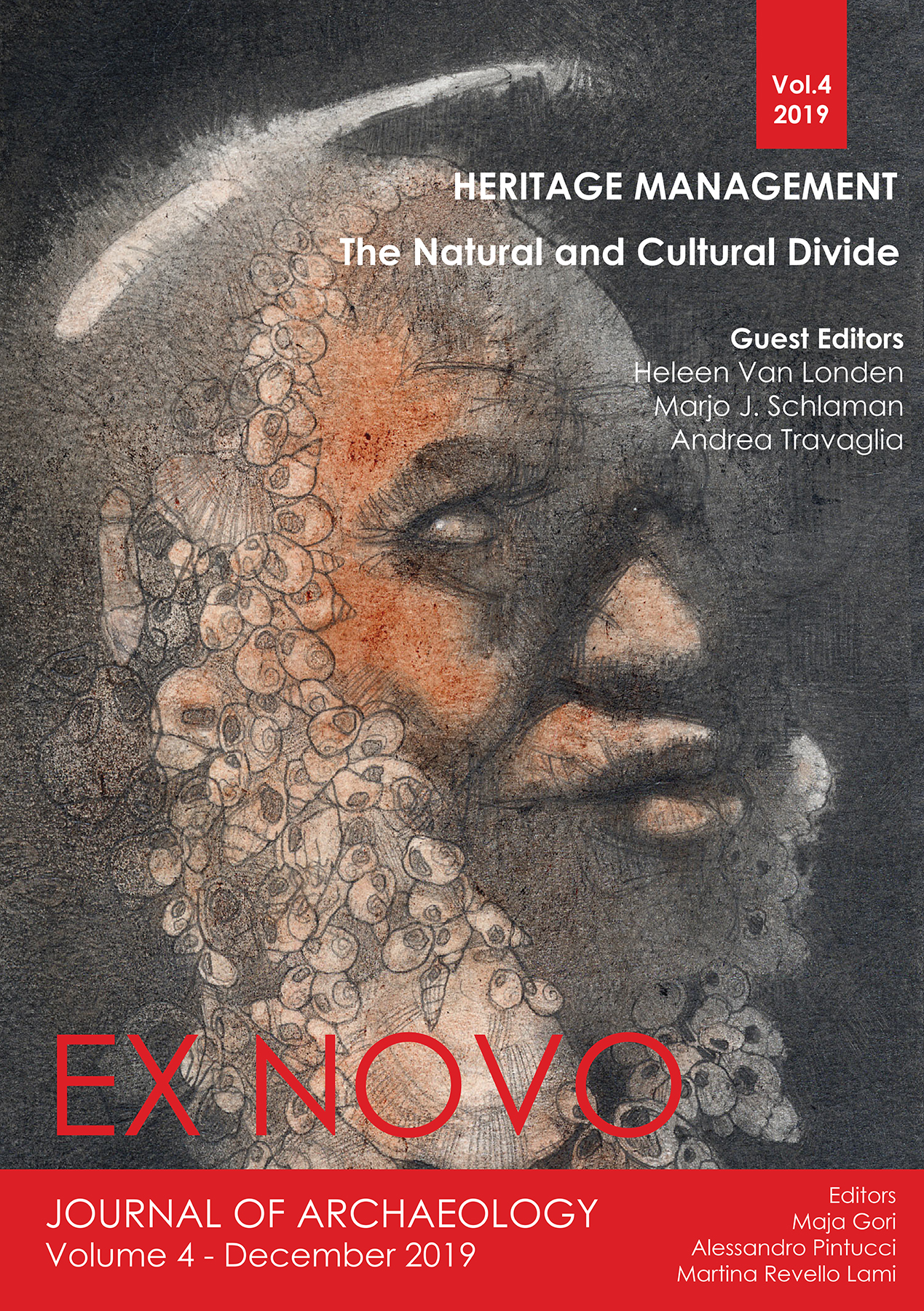The culture and nature assets. The current crossovers and the agenda for the future
DOI:
https://doi.org/10.32028/exnovo.v4i0.375Keywords:
Natural Heritage, Cultural Heritage, Climate, Public Engagement, SustainabilityAbstract
The paper intends to provide an overview of major crossovers between cultural and natural heritage appearing and executing in political, administrative, economic, societal and academic domains. It discusses complicated processes that have led to overcoming a separation between these two largely distinct domains, which is strikingly embedded in western philosophy. The relevance of such crossovers is examined in the context of challenges imposed by the climate change and major shifts in the understanding of heritage and its role in the society. It concludes by providing some thoughts on the character of the future crossovers between cultural and natural heritage more effectively engaging with the contemporarily emergent issues of social significance.
References
Ahern, J., 2006. Theories, methods and strategies for sustainable landscape planning, in: B. Tress, G. Fry & G. Opdam (eds), From Landscape Research to Landscape Planning. Aspects of Integration, Education and Application. Dordrecht: Springer, 119–131.
Aldred, O., & Fairclough, G., 2003. Historic Landscape Characterization. Taking Stock of the Method. London: English Heritage.
Antrop, M. 2006. Sustainable landscapes: contradiction, fiction or utopia?. Landscape and Urban Planning 75(3), 187–197.
Balée, W., 1998. Historical ecology: premises and postulates, in: W. Balée (ed.), Advances in Historical Ecology. New York: Columbia University Press, 13–29.
Bell, M., 2004. Archaeology and green issues, in: J. Bintliff (ed.), A Companion to Archaeology.
Malden, Oxford, Victoria: Blackwell Publishing, 509–531.
Bloemers, T., Daniels, S., Fairclough, G., Petroli & Stiles, R. (eds), 2010. Landscape in a Changing World; Bridging Divides, Integrating Disciplines, Serving Society. Strasbourg/Brussels: European Science Foundation ESF-COST.
Bohnet, I., 2010. The contribution of modelling and stakeholder engagement to transdisciplinary landscape research: an exploration of the Landscapes Toolkit, in: D.A.
Swayne, Y. Wanhong, A.A. Voinov, A. Rizooli & T. Filatova (eds), International Environmental Modelling and Software Society (iEMSs) 2010 International Congress on Environmental Modelling and Software Modelling for Environment’s Sake. Ottawa: Fifth Biennial Meeting. http://www.iemss.org/iemss2010/index.php?n=Main.Proceedings.
Coen, D. 2018. Climate in Motion: Science, Empire, and the Problem of Scale. Chicago & London: The University of Chicago Press.
Convention for the Protection of the Archaeological Heritage of Europe, 1992, Council of Europe. European Treaty Series No. 143. Accessed 27/11/2019 https://rm.coe.int/168007bd25
Council Of Europe Framework Convention On The Value Of Cultural Heritage For Society, 2005. Accessed 27/11/2019. https://www.coe.int/en/web/conventions/full-list/-/conventions/treaty/199
Crumey, C. 2014. What is historical ecology. Accessed 17/11/2019. http://www.hercules-landscapes.eu/blog.php?what_is_historical_ecology&id=10
Cultural Landscapes, UNESCO 2019. Accessed 27/11/2019. https://whc.unesco.org/en/culturallandscape/#1.
Culture heritage in EU policies, 2018. Accessed 27/11/2019. http://www.europarl.europa.eu/RegData/etudes/BRIE/2018/621876/EPRS_BRI(2018)621876_EN.pdf.
Dale, V.H., Brown, S., Haeubner, R.A., Hobbs, N.T., Huntly, N., Naiman, R.J., Riebsame,
W.E., Turner, M.G. & Valone, T.J., 2000. Ecological principles and guidelines for managing the use of land. Ecological Applications 10(3), 639–670.
Egoz, S., Makhzoumi, J. & Pungetti, G. (eds), 2011. The Right to Landscape. Contesting Landscape and Human Rights. London: Ashgate.
European Landscape Convention. 2000, Council of Europe. European Treaty Series No. 176. Accessed 27/11/2019. https://rm.coe.int/1680080621.
González-Ruibal, A., González, P.A. & Criado-Boado, F., 2018. Against reactionary populism: towards a new public archaeology. Antiquity 92(362), 507–515.
Graham, B., 2002. Heritage as knowledge: capital or culture?. Urban Studies 39 (5-6), 1003–1017.
Guidance Manual for the Country Studies, 2013. Accessed 27/11/2019. http://www.teebweb.org/media/TEEB_GuidanceManual_2013_chapter-1.pdf.
Guidelines on the inscription of specific types of properties on the World Heritage List. Annex 3, 2013. Accessed 27/11/2019. https://whc.unesco.org/archive/opguide05-annex3-en.pdf.
Harrison, R., 2015. Beyond “natural” and “cultural” heritage. Toward an ontological politics of heritage in the age of Anthropocene. Heritage & Society 8 (1), 24–42.
Latour, B., 2011. Politics of nature: East and West perspectives. Ethics & Global Politics 4(1), 1–10.
Marciniak, A., Pawleta, M. & Kajda. K., (eds), 2018. Dziedzictwo we współczesnym świecie: kultura - natura – człowiek. Kraków: Universitas.
Palang, H., Alumae, H., & Mander, U., 2000. Holistic aspects in landscape development: a scenario approach. Landscape and Urban Planning (50), 85–94.
Richerson, P., Mulder, M.& Vila, B., 1996. Principles of Human Ecology. Needham Heights: Simon & Schuster.
http://www.thebreakthrough.org/images/Death_of_Environmentalism.pdf
Roymans, N., Gerritsen, F., Van Der Heijden, C., Bosma, K. & Kolen, J., (eds), 2009. Landscape biography as research strategy. The case of the South Netherlands Project. Landscape Research 34(3), 337–359.
Skoglund, P. & Svensson, E., (eds), 2010. Discourses of nature conservation and heritage management in the past, present and future. Discussing heritage and sustainable development from Swedish experiences. European Journal of Archaeology 13(3), 368–385.
Taylor, G.M., 2009. Systems thinking: The key to survival. 53rd Annual Conference of the International Society for the Systems Sciences 2009: Making Liveable, Sustainable Systems Unremarkable 1, 90–115.
Territorial Agenda of the European Union 2020, 2011. Accessed 27/11/2019. https://ec.europa.eu/regional_policy/sources/policy/what/territorial-cohesion/territorial_agenda_2020.pdf.
The Consolidated Treaty on the Functioning of the European Union, 2012. Accessed 27/11/2019. https://eur-lex.europa.eu/LexUriServ/LexUriServ.do?uri=CELEX:12012E/TXT:EN:PDF.
The Florence Declaration on Heritage and Landscape as Human Values 2014. ICOMOS. 2014. Accessed 27/11/2019. https://www.icomos.org/images/DOCUMENTS/Secretariat/2015/GA_2014_results/GA2014_Symposium_FlorenceDeclaration_EN_final_20150318.pdf.
United Nations Report of the World Commission on Environment and Development. Our Common Future. 1987. Accessed 27/11/2019. https://www.are.admin.ch/are/en/home/sustainable-development/internationalcooperation/2030agenda/un-_-milestones-in-sustainable-development/1987--brundtlandreport.html.
Valk, van der, A., 2010. Planning the past. Lessons to be learned from ‘Protecting and Developing the Dutch Archaeological-Historical Landscape, in: T. Bloemers, H. Kars, A. van der Valk & M. Wijnen (eds), The Cultural Landscape and Heritage Paradox. Protection and Development of the Dutch Archaeological-Historical Landscape and its European Dimension. Amsterdam: Amsterdam University Press, 21–53.
Downloads
Published
How to Cite
Issue
Section
License
Copyright (c) 2019 Ex Novo: Journal of Archaeology

This work is licensed under a Creative Commons Attribution-NonCommercial-NoDerivatives 4.0 International License.






